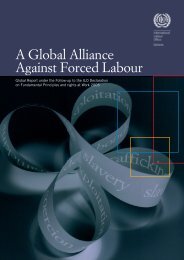equal by law, unequal by caste - International Dalit Solidarity Network
equal by law, unequal by caste - International Dalit Solidarity Network
equal by law, unequal by caste - International Dalit Solidarity Network
You also want an ePaper? Increase the reach of your titles
YUMPU automatically turns print PDFs into web optimized ePapers that Google loves.
Vol. 26, No. 2 Equal <strong>by</strong> Law, Un<strong>equal</strong> <strong>by</strong> Caste 259problems of minority groups in general.” 12 He pledged support foraffirmative action programs specifically targeting <strong>Dalit</strong>s, stating thatIndia’s government “is deeply and sincerely committed to the <strong>equal</strong>ity ofall sections of our society and will take all necessary steps to help in thesocial, educational and economic empowerment of dalits.” 13The analogy is an apt one on many levels, and an uncomfortableone on others. Like South Africa, those who sit atop the <strong>caste</strong> pyramidare a numerical minority. When combined, the population of <strong>Dalit</strong>s,“tribals,” “Other Backward Classes,” and religious minorities faroutnumber those of “upper-<strong>caste</strong>” Hindus. 14 But the analogy revealssomething far deeper, that the system of “untouchability” in Indiacontinues to operate as though a form of legal apartheid were effectivelystill in place.In many ways the <strong>Dalit</strong> condition naturally invites suchcomparisons, 15 and in others it is a singular category, cutting across theIndian subcontinent, but categorically different than discrimination onthe basis of race. To begin, the visual cues that accompanied apartheidin South Africa, or racial discrimination in other parts of the world, arelacking in India. Caste is like oxygen—it is both invisible andindispensable. While the absence of obvious racial cues does not preventthe system from functioning to the detrimental exclusion of those whofall below the “pollution line,” 16 a general lack of Western familiaritywith a non-racial paradigm does frustrate international attention andintervention.1213141516Id.Government Committed to Redress Inequities: Dr. Manmohan Singh, HINDUSTAN TIMES, Dec.27, 2006.According to the 2001 Census, India’s population breaks down along the following lines:scheduled <strong>caste</strong>s (“SC”) 16.2 percent; scheduled tribes 8.2 percent; Muslims 13.4 percent;Christians 2.3 percent; Sikhs 1.9 percent; Buddhists 0.8 percent; Jains 0.4 percent; and others0.6 percent. See Census of India, Census Data 2001, available at http://www.censusindia.gov.in/Census_Data_2001/India_at_glance/scst.aspx. The percentage of the population that falls underthe category of “other backward classes” (“OBCs”) is the subject of much debate. The MandalCommission, set up <strong>by</strong> the government in 1979 to identify “socially or educationally backward”classes, estimated in 1991 that OBCs comprise 52 percent of the population. A 2007 survey <strong>by</strong>the National Sample Survey Organization (“NSSO”), however, puts this population at 41 percentand the SC population just under 20 percent. OBCs are seen to be lower in the <strong>caste</strong> ranking butabove “untouchables” and are therefore not treated as untouchable. According to the NSSOsurvey, the proportion of the population that is “upper-<strong>caste</strong>” Hindus is 25.5 percent. See OBCsForm 41% of the Population: Survey, TIMES OF INDIA, Sept. 1, 2007 available athttp://timesofindia.indiatimes.com/articleshow/msid-2328117.cms (last visited Aug. 14, 2008).See, e.g., V. T. RAJSHEKAR, DALIT: THE BLACK UNTOUCHABLES OF INDIA (3rd ed. 1995).See infra Part II.C.1.
















